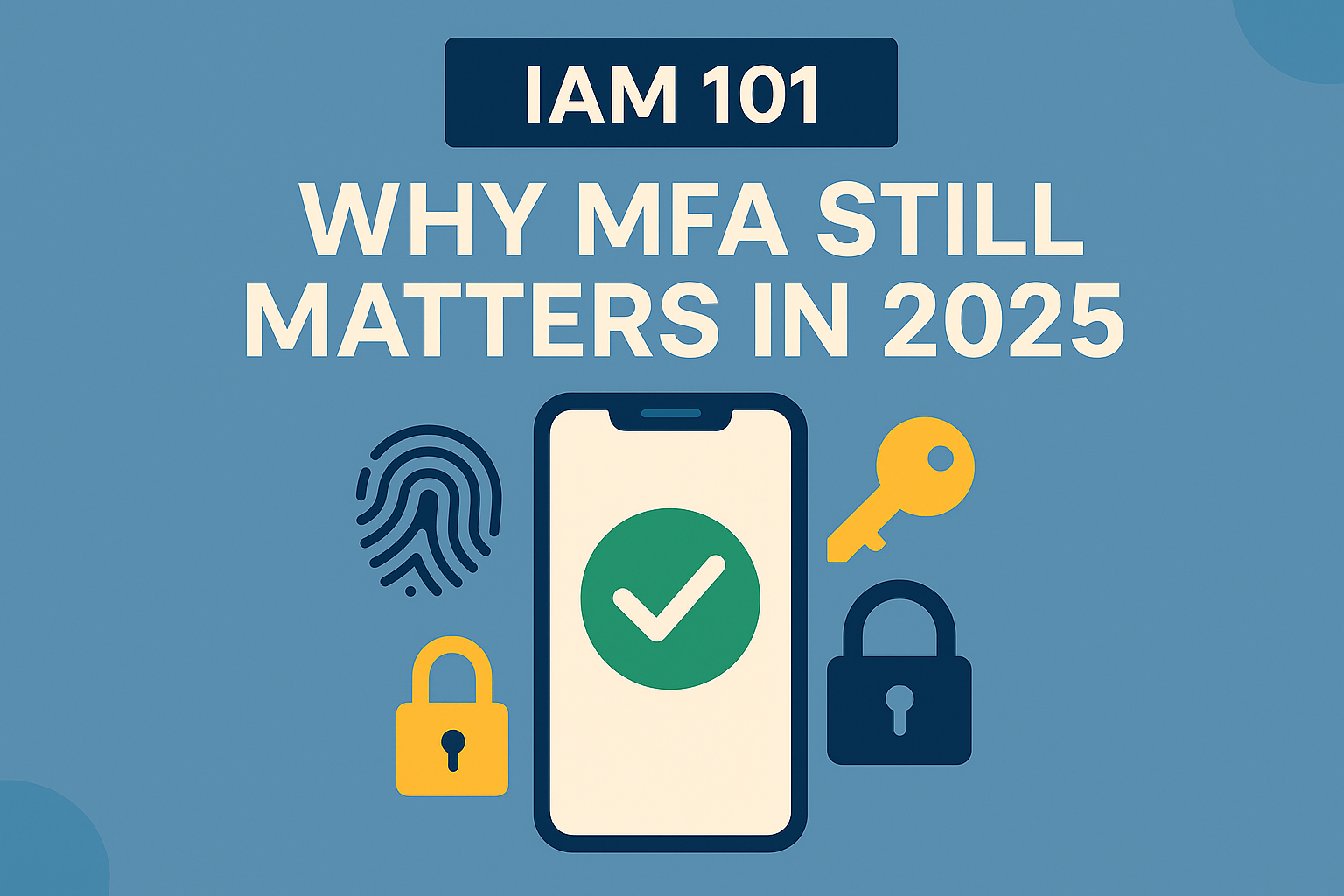
TL;DR
Multi-Factor Authentication (MFA) remains one of the most effective and underutilized defenses in modern cybersecurity. Despite being widely available, it’s often poorly implemented or misunderstood. In this post, we break down:
- Why MFA is still essential in 2025
- Common MFA methods (and which to avoid)
- How attackers are bypassing MFA
- Best practices for enterprise adoption
🔍 Background
Fifteen years into IAM, I’ve watched the industry shift from passwords to push prompts, biometrics, and passkeys. And yet—many organizations still treat MFA as a box to check, not a real control.
The reality is that MFA isn’t going away—it’s evolving.
Credential phishing, session hijacking, and MFA fatigue are on the rise. But so are stronger defenses like FIDO2, phishing-resistant MFA, and adaptive access.
Let’s explore what’s working—and what’s not—in the real world.
🧠 What is Multi-Factor Authentication?
MFA adds one or more layers of identity verification beyond a simple username and password.
The Three Factor Types:
| Factor Type | Description | Example |
|---|---|---|
| Something you know | A shared secret | Password, PIN |
| Something you have | A physical or digital possession | Mobile phone, security key |
| Something you are | A biometric identifier | Fingerprint, face scan |
The more independent the factors, the better your protection.
🔐 Common MFA Methods
| Method | Description | Risk Level |
|---|---|---|
| SMS Codes | One-time codes sent via text message | 🚫 Vulnerable to SIM swapping |
| TOTP Apps | Time-based tokens (Google Authenticator, Authy) | ✅ Safer than SMS |
| Push Notifications | Tap to approve login on phone (e.g., Okta Verify) | ⚠️ Prone to fatigue |
| Hardware Security Keys | USB/NFC devices (e.g., YubiKey, Titan) | ✅✅ Phishing-resistant |
| Biometrics | Fingerprint, Face ID (when securely stored) | ✅ Strong, but device-tied |
| Passkeys (FIDO2) | Passwordless cryptographic login tied to device identity | ✅✅ Next-gen secure login |
🧱 Why MFA Still Matters in 2025
Credential Theft is Still the #1 Attack Vector
According to Verizon’s 2024 DBIR, over 74% of breaches involve stolen or weak credentials. MFA breaks that chain—even if passwords leak.Cloud + Hybrid = More Entry Points
From SaaS to BYOD to remote work, users are accessing critical systems from everywhere. MFA gives you control at the access edge.Compliance Isn’t Optional
HIPAA, PCI-DSS, SOX, GDPR, CJIS, and CMMC all require MFA. It’s not just best practice—it’s mandated.Zero Trust Depends on It
You can’t “never trust, always verify” if you don’t verify the user beyond a static password.
⚠️ MFA Isn’t Foolproof
Here’s where I’ve seen MFA fail:
| Problem | Description | Example |
|---|---|---|
| MFA Fatigue | Users blindly approve prompts | Attacker sends repeated push requests until one is accepted |
| Phishable Methods | Links or codes can be intercepted | Fake login pages harvesting OTPs |
| Inconsistent Enforcement | Only some apps are protected | Email protected, Salesforce wide open |
| Poor User Education | Users don’t understand risk | “Why do I have to do this again?” syndrome |
Lesson: Not all MFA is created equal. Enforcing it poorly can create a false sense of security.
🧰 Best Practices for Implementing MFA
✅ Use Phishing-Resistant MFA Wherever Possible
Prefer FIDO2, WebAuthn, or security keys for admin and privileged access.
✅ Mandate MFA at the IdP Level
SSO only works securely if MFA is enforced at the front door (e.g., Okta, Entra ID, Ping).
✅ Phase Out SMS and Email Codes
They’re better than nothing—but not by much. SIM swaps and email compromises are easy wins for attackers.
✅ Monitor for MFA Fatigue
Use tools that detect repeated push requests and block suspicious activity.
✅ Educate and Enforce Consistently
Roll out training with your MFA policy. Make it part of onboarding. And enforce it on every app—no exceptions.
📚 Cited Study
According to a 2024 Microsoft Identity Security Report, users with FIDO2-based MFA were 99.9% less likely to suffer from account compromise than users with SMS or email MFA.
🧭 Final Thoughts
MFA in 2025 isn’t about just adding a second step—it’s about adding the right second step. If you’re relying on SMS or inconsistent enforcement, you’re still exposed.
Done right, MFA is the easiest high-impact control you can deploy today.
Start with your high-value targets (admins, finance, HR). Roll out secure MFA with strong policies. Educate your users. And watch your attack surface shrink.
🚀 Up Next in the Series:
👉 IAM 101: Privileged Access Management – Managing High-Risk Accounts